Podwal’s Books
Mark Podwal is a busy, busy man. He has spent the last 38 years making every conceivable kind of art: innumerable paintings, 28 illustrated books written by him and the likes of Elie Wiesel, Harold Bloom and Francine Prose, children’s books, Haggadot, ceramics and graphic works. Dubbed the “Master of the True Line” by author Cynthia Ozick he has been seen on the Op-Ed pages of the New York Times since 1972 with pro-Israel political cartoons and drawings. Lately his passion for the Jewish community in Prague has expressed itself in a book, Built by Angels: The Story of the Old-New Synagogue and a documentary film House of Life: The Old Jewish Cemetery in Prague narrated by Claire Bloom. His art is found in the Metropolitan Museum of Art, Victoria and Albert Museum, Fogg Art Museum and Library of Congress. The Forum Gallery in New York has represented him since 1977. He also happens to be a Board-certified dermatologist. What is easily most remarkable about this breathless list of accomplishments is that his artwork has consistently focused on Jewish legend, history and tradition.
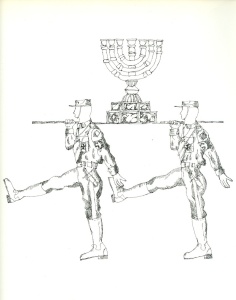
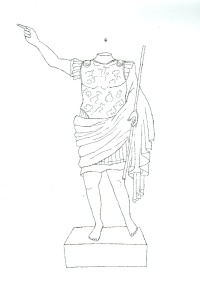
In one of his earliest Jewish texts Podwal teams up with the Prophet Jeremiah to illustrate Lamentations (1974) in a series of searing images delineating the tragedies of Jewish history that the prophet foretells. Podwal’s signature style is already evident; a powerfully simple line combines with acidic social commentary to bring an ancient text into contemporary consciousness. The frontispiece is a line drawing that copies the well-known Baroque arch and framing columns of countless Talmuds and sacred texts. On the pediment “Echah” is inscribed with “Kinot for Tisha b’Av” in Hebrew in the empty archway. A lone noose hangs above the inscription, wrenching us from ancient history to modern day persecutions.
So too the verse “The adversary has spread out his hand upon all her treasures. For she has seen that the heathen have entered into her sanctuary” (1:10). Podwal keeps us in the present, depicting two Nazi storm troopers marching off with the Temple menorah found on the Roman Arch of Titus. Similar in sentiment, but somehow more vicious, is the illustration from chapter 5:1-2 where we see the Roman Capitoline Wolf (symbol of the founding of Rome) staring defiantly at us and ironically crowned with a 18th century Polish Torah crown and grasping an ornate menorah in its savage teeth. For Podwal Rome continues to oppress well after its own demise.
In 1984 Podwal created A Jewish Bestiary: A Book of Fabulous Creatures Drawn from Hebraic Legend and Lore. It is a remarkable transformation of a medieval Christian tradition tracing its roots to Greek, Roman, Egyptian and Indian literature. A bestiary is a natural history of animals that expounds a moral lesson. Podwal’s choices are revealing of his deep and passionate love of Torah, Talmud and later commentaries. His purpose in illuminating these animals is to “perpetuate their ancient enchantment.” Using midrash he proceeds to visually elucidate the purpose of the ant, serpent, fox, the dove and the lion among the other 25 animals he illustrates. For the ram, seen entangled on a menorah-like bush, its role is explicated in the Akeidah and its horns; “the left one was sounded after the Revelation on Mount Sinai, the other to proclaim the advent of the Messiah.”
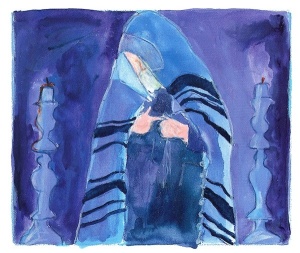
While the ostrich is kind of funny, a big bird with a talis covering its comic small head, the gnat is most revealing. This species had a specific historical role to play in the retribution of the especially evil Titus who violated the Temple well beyond God’s furious command of destruction. The tiny gnat flew into Titus’s nose and then to his brain and tortured him for seven years until he died of its incessant buzzing. Podwal’s simple drawing of the triumphant Roman, his head replaced by a single gnat, proclaims how justice was done by this lowly insect.
And then there was Schmuel the Shoemaker. In You Never Know: A Legend of the Lamed-vavniks (1998), written by Francine Prose, the notion of holiness hidden in our midst is lovingly explored in this Eastern European Jewish tale. Podwal’s illustrations are uncharacteristically restrained. The hero is seen most poignantly as a humble man hidden in the purple of shadows, contemplating what the needs of his little town are. Nonetheless, this simple pious Jew who simply wished to help his fellow man saved his entire town from disaster. We are urged by his illustrations to reflect upon the subtle notion of how simple kindness can engender great blessings.
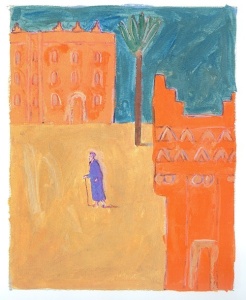
In some ways Podwal seems to be most at home with demons. His illustrations for the award winning children’s book King Solomon and His Magic Ring (1999), written by Elie Wiesel, takes us into the totally magical world of King Shlomo. In this delightful retelling of many midrashim the fabled King Solomon seemed to know everything and had intimate access to God Himself who gave him a magic ring extending his authority over all spirits, demons and animals in the universe. The demons and animals were totally under his control, seemingly happy to do his bidding. We see two winged demons happily perched atop the humps of a passing camel and are told that some of the animals actually lined up outside the royal kitchen eagerly awaiting to be served as the king’s dinner!
The legend of the king of the demons, Ashmedai, dominates the last quarter of the book with some of Podwal’s best images propelling the story. The wicked Ashmedai is seen as a grumpy gremlin, adorned with enormous bat wings and little white horns. After he steals Shlomo’s ring and therefore his power, we seem him transformed as a look-alike King Solomon and the real king reduced to wandering the world as an impoverished vagrant. Even though he finally regains his magic ring and his rightful throne, Shlomo is chastened, filled with a new kind of wisdom.
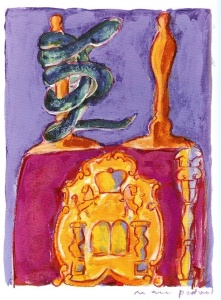
Podwal’s latest book collaboration, Fallen Angels (2007) is with noted author Harold Bloom and examines the recent fascination with angels, especially those that might be called fallen out of heavenly favor. This distinctly non-Jewish idea is developed by Bloom into the notion that in some fundamental way we are all fallen angels. Podwal explicates the Jewish expression of this in his illumination of Good and Evil. The top of a Torah scroll is seen; complete with mantle, yad and etz chaim, and one of the staves is wrapped with an entangled snake. This at first shocking notion that the Torah could contain both good and evil slowly resolves itself as we ponder the reality of our sacred covenant. Isaiah said it best, quoting God: “I form light and create darkness, I make peace and create evil (45:7).” How can such things be contained in one Torah, authored by one God? That is of course the fundamental tenet of our affirmation of faith, the proclamation of the Shema.
Through a lifetime of drawings and artwork, thinking and considering things Jewish, Mark Podwal’s love of the Torah and the Jewish people rings loud and clear. The struggle with the sufferings, contradictions and conundrums of heaven and earth cannot help but color his clever and perceptive images. His subjects include angels, demons, lamed-vavniks, golems, dybbuks and the messiah, all of which betray a fascination with the edges of reality, striving to visualize that which is not quite there. Once he is done with them, we have peeked around the corner of our consciousness and come back a bit wiser.
Podwal’s Books
Illustrated Books by Mark Podwal
Markpodwal.com